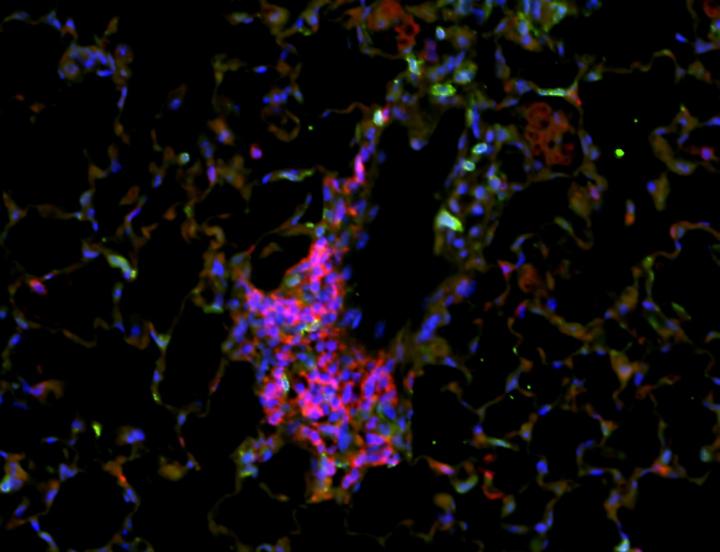
Credit: Helmholtz Zentrum München
More than 250 million people suffer from COPD, a progressive inflammatory lung disease. On the list of the most frequent causes of death worldwide, COPD ranks third behind heart attacks and stroke. The primary cause of COPD is exposure to cigarette smoke. Ninety percent of COPD patients are or have been chronic smokers. Other risk factors include exposure to air pollution. Despite intensive research efforts, there is no cure for COPD. Resulting fibrosis and lung epithelial cell death are key features of COPD, preventing patients from breathing effectively. Current therapies focus on relieving symptoms (mainly breathlessness and cough with phlegm) and reducing the progression of the disease and its comorbidities (mainly muscle wasting). In severe cases, patients are in need of lung transplantation.
Focus on tissue regeneration
“One of the biggest issues in COPD is that the lung cannot regenerate itself”, says Dr. Ali Önder Yildirim, Director at the Institute of Lung Biology and Disease at Helmholtz Zentrum München and lead of the new study. “Therefore, a treatment that cures the disease needs to focus on lung tissue regeneration and blocking of lung epithelial cell death.”
In 2009, the research group of Univ. Prof. Mathias Heikenwälder at DKFZ prevented liver tissue from chronic inflammation and fibrosis. They had achieved this by blocking the lymphotoxin beta receptor signaling pathway within the liver, which is responsible for the activation and organization of immune cells as well as for chronic liver inflammation leading to fibrosis. “This is why we have long suspected that the blocking of lymphotoxin beta receptor could also play a role in regenerative processes in other organs,” explains Heikenwälder.
The development of diseases in the liver and the lung show many similarities. In COPD, immune cells form newly organized structures in the lung, so called tertiary follicles, which are known to play an important role in the disease progression. The formation of these follicles requires the activation of the lymphotoxin beta receptor in the lung – the same receptor which was targeted in Heikenwälder’s study in the liver. “We wanted to investigate on the role of this receptor and its signaling in COPD and whether we might be able to use it in a therapeutic setting”, says Yildirim. The researchers therefore blocked the signaling of the lymphotoxin beta receptor in lungs of mice which had developed smoke-induced COPD typical immune cell follicles, fibrosis and lung epithelial cell death.
Full restoration of lung tissue in mice
The result: Blocking of lymphotoxin beta receptor signaling in mice lung tissue disrupted the formation of the immune cell follicles, prevented lung epithelial cell death and, surprisingly, at the same time triggered lung tissue regeneration. “The lung in those mice regenerated despite the continuous exposure to chronic cigarette smoke. We observed a full restoration of lung tissue”, says Dr. Thomas M. Conlon, part of Yildirim’s group at Helmholtz Zentrum München. “Moreover, as the mice lungs healed, co-morbidities such as muscle wasting also improved.”
The researchers found that the regeneration of compromised lung epithelial cells is induced by so-called Wnt signaling which is automatically activated through the blocking of lymphotoxin beta receptor signaling in those cells. “Wnt signaling is an essential pathway for lung development. In COPD, it gets switched off preventing lung tissue from being able to repair and regenerate” says Heikenwälder. In previous experiments, re-activation of Wnt signaling in mice has been proven to induce lung repair.
Novel therapeutic approach
“This could become a novel therapeutic approach for COPD. Our idea is to develop lymphotoxin beta receptor blockers for COPD which reduce lung epithelial cell death and lung inflammation. The automatic activation of Wnt signaling could then induce lung tissue regeneration”, says Yildirim.
In first preclinical experiments, the group showed that the lymphotoxin beta receptor signaling in human lung tissue is identical to the signaling in mice. This offers great potential for implementing lung regenerative medicine approaches in the clinic. To achieve this ultimate goal, the researchers aim to test this novel therapeutic approach published in Nature journal in human clinical trials over the coming years.
###
Original publication
Conlon et al., 2020: Inhibition of LTβR-signaling activates Wnt-induced regeneration in lung. Nature,
DOI: 10.1038/s41586-020-2882-8
Helmholtz Zentrum München
Helmholtz Zentrum München is a research center with the mission to discover personalized medical solutions for the prevention and therapy of environmentally-induced diseases and promote a healthier society in a rapidly changing world. It investigates important common diseases which develop from the interaction of lifestyle, environmental factors and personal genetic background, focusing particularly on diabetes mellitus, allergies and chronic lung diseases. Helmholtz Zentrum München is headquartered in Neuherberg in the north of Munich and has about 2,500 staff members. It is a member of the Helmholtz Association, the largest scientific organization in Germany with more than 40,000 employees at 19 research centers.
Media Contact
Verena Schulz
[email protected]
Original Source
https:/
Related Journal Article
http://dx.




